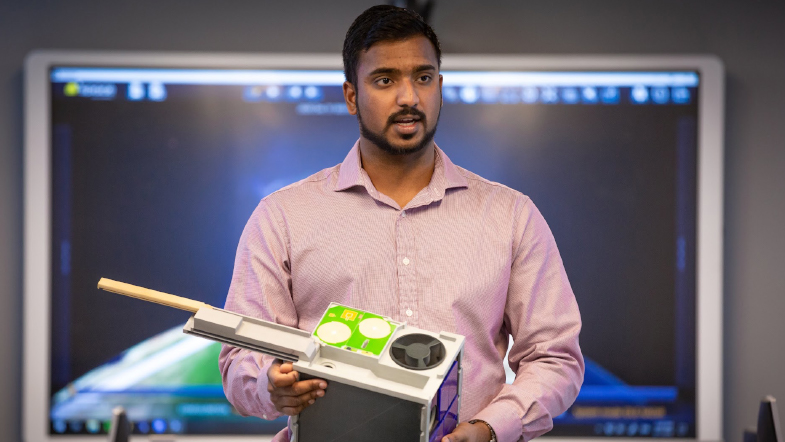Thermal software speeds up the space race
Clint Therakam first came to UNSW Canberra Space in 2018 to attend a student engineering workshop.
Clint Therakam first came to UNSW Canberra Space in 2018 to attend a student engineering workshop.

Clint Therakam first came to UNSW Canberra Space in 2018 to attend a student engineering workshop. This year he returned as a full-time member of the team with an integral role as Thermal Engineer in upcoming satellite missions.
“To be working in this University in the space department is nothing short of amazing,” Mr Therakam said.
“Being able to make these simulations and, as a result, potentially critical decisions on the satellite, that’s honestly a dream come true for a young engineer like me.”
Like many kids growing up, he thought about becoming an astronaut, but at university he discovered he enjoyed the technical side of space operations.
At UNSW Canberra he has developed a thermal solver that can analyse how a spacecraft will react to the drastic temperature changes it will experience in space.
“Cubesats generally sit at comfortable temperatures – roughly room temperature, give or take 10 degrees, but in the peaks you can go in wider ranges. Perhaps all the way from minus-30 to plus-70 degrees Celsius,” Mr Therakam said.
“It’s a complex analysis in terms of allowing all the parts to survive, but also not jeopardising things like the power requirements.”
Mr Therakam’s solver can address these problems accurately and efficiently.
“The software power we have now is fantastic,” Mr Therakam said.
“In the past engineers would run a simulation and it would take hours and hours. I’ve written a code and I can just run my software and know it’s getting too hot in under a couple of minutes. In the past they’d have to do physical testing or wait hours for the simulation to go through. We’ve come a long way since then.”

While thermal software is commercially available, Mr Therakam’s solver has been specifically designed to work with UNSW Canberra Space’s Australian National Concurrent Design Facility. It is the go-to tool for the team and external partners to conceptualise new space missions.
As the name suggests, the facility allows each member of the team to contribute their part to the project concurrently, speeding up the design process.
Mr Therakam explained that satellites can take years to design because the decisions made by each engineer will affect the entire team.
“For example, the structural engineering needs to know what parts to put in the satellite. The size of these parts would limit what the power engineer could use in terms of the size of the battery. If it’s too big, then it will cost too much and that would affect the budget,” he said.
“But this facility forces each engineer to make assumptions and make decisions they’re uncomfortable with. When everyone makes their decisions, you can get something that works and instead of having a hundred different problems along the way, you have five problems that you can solve.”
An efficient design process is now more important as the world becomes more reliant on satellite technology.
“There’s so many opportunities popping up all over the world - it’s almost a new space race.” Mr Therakam said.
“Australia is well placed to provide some interesting contributions to international space missions and I think with a lot of the work that universities are doing it’s just going to improve over the next few years.”
Related stories
Future aerospace leaders simulate space mission at UNSW Canberra
Satellites and emergency response
UNSW Canberra Space collaborates with New Zealand scientists